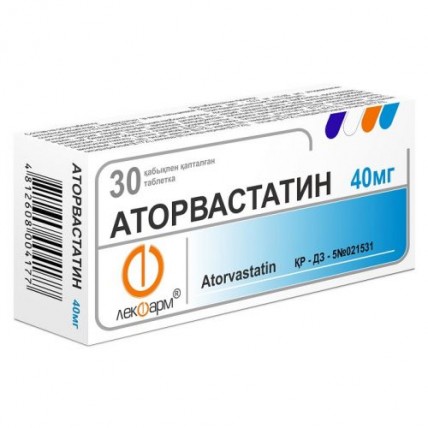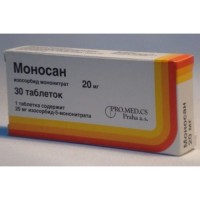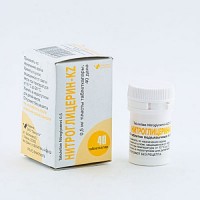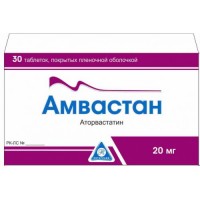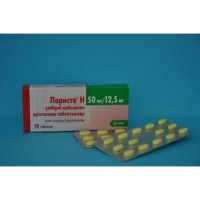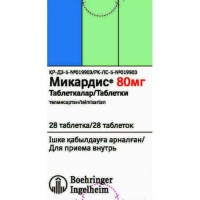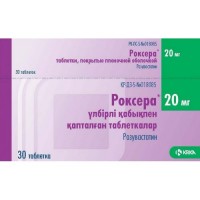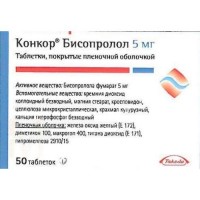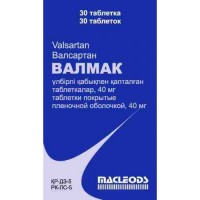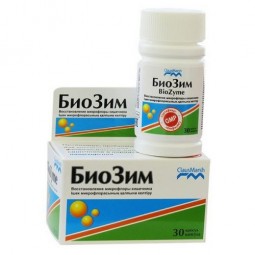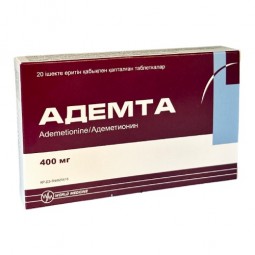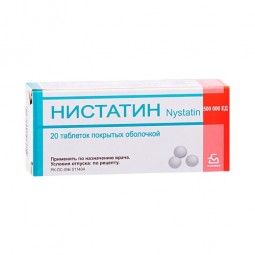Atorvastatin 40 mg coated (30 tablets)
- $19.80
The instruction for medical use of ATORVASTATIN medicine the Trade name Atorvastatin Mezhdunarodnoye the unlicensed name Atorvastatin Lekarstvennaya the Tablet form, coated, 10 mg, 20 mg and 40 mg One tablet contains Structure: active agent - atorvastatin (in the form of calcic salt of trihydrate) 10 mg, 20 mg and 40 mg (10.85 mg, 21.70 mg and 43.40 mg), excipients: calcium carbonate, krospovidon, sodium lauryl sulfate, silicon dioxide colloidal anhydrous, talc, cellulose microcrystalline, structure of a cover: opadray II pink (talc, polyethyleneglycol, titan dioxide (E171), polyvinyl alcohol, gland (III) oxide yellow (E172), gland (III) oxide red (E172), gland (III) oxide black (E172)). The description of the Tablet, coated pink color, with a biconvex surface Pharmacotherapeutic group Hypolipidemic drugs. Gipokholesterinemichesky and gipotriglitseridemichesky drugs. HMG CoA-reductases inhibitors. Atorvastatin. The ATX C10AA05 code the Pharmacological Atorvastatin Pharmacokinetics Absorption properties is quickly soaked up after oral administration, its concentration in blood plasma reaches the maximum level for 1-2 h. The relative bioavailability of an atorvastatin is 95-99%, absolute – 12-14%, system (providing HMG-CoA reductase inhibition) – about 30%. The low system bioavailability is explained with presistemny clearance in a mucous membrane of digestive tract and/or metabolism at the first passing through a liver. Absorption and concentration in blood plasma increase in proportion to a drug dose. In spite of the fact that at reception with food the absorption of drug decreases (the maximum concentration and AUC - approximately for 25 and 9% respectively), decrease in the LDL level XC does not depend on that, was accepted atorvastatin together with food or not. At reception of an atorvastatin in the evening its concentration in blood plasma was lower (about 30% for the maximum concentration and AUC), than at morning reception. However decrease in the LDL level XC does not depend on time of administration of drug. More than 98% of drug contact proteins of blood plasma. Erythrocyte/plasma makes ratio coefficient about 0.25 that demonstrates weak penetration of drug into erythrocytes. Atorvastatin's metabolism is metabolized to orto- and parahydroxylated derivatives and various beta oxidized products. The inhibiting effect of drug concerning GMG-KoA-reduktazy approximately for 70% is implemented due to activity of the circulating metabolites. It is established what atorvastatin is weak inhibitor of P450 ZA4 cytochrome. Atorvastatin's removal and his metabolites are allocated mainly with bile after hepatic and/or extrahepatic metabolism. However drug is not subject to significant enterohepatic recirculation. Average elimination half-life of an atorvastatin makes nearly 14 h, but the period of inhibitory activity concerning GMG-KoA-reduktazy thanks to the circulating active metabolites is 20-30 h. Less than 2% of the dose of an atorvastatin accepted orally are allocated with urine. Pharmacokinetics at special groups of patients Concentration of an atorvastatin in blood plasma of healthy faces of advanced age (65 years) higher (about 40% for the maximum concentration and 30% are more senior - for AUC), than at young people. Differences in efficiency of treatment atorvastatiny at patients of advanced age and patients of other age groups are not revealed. Concentration of an atorvastatin in blood plasma at women differs from concentration in blood plasma at men (at women the maximum concentration about 20% higher, and AUC – is 10% less). However clinically reliable difference in influence on the level of lipids at men and women is not revealed. Diseases of kidneys do not affect concentration of drug in blood plasma or on influence of an atorvastatin on the level of lipids therefore patients have no need for dose adjustment of drug with a renal failure. The conducted researches did not cover patients with an end-stage of a renal failure probably a hemodialysis significantly does not change clearance of an atorvastatin as drug almost completely contacts proteins of blood plasma. Concentration of an atorvastatin in blood plasma significantly increases (the maximum concentration – approximately by 16 times, AUC - by 11 times) at patients with cirrhosis of an alcoholic etiology. The pharmacodynamics Atorvastatin is a selection competitive inhibitor of GMG-KoA-reduktazy-enzima which regulates the speed of the GMG-KoA transformation in mevalonat - the predecessor of sterols (including cholesterol (XC)). At patients with a homozygous and heterozygous family hypercholesterolemia, not hereditary form of a hypercholesterolemia and the mixed dislipidemiya atorvastatin reduces concentration of the general of XC, lipoproteids of the low density (LDL) and apolipoprotein B (Apo C). Atorvastatin also reduces concentration of lipoproteids of very low density (LPONP) and triglycerides (TG) and also increases the maintenance of the XC lipoproteids of the high density (LPVP) a little. Atorvastatin reduces level XC and lipoproteids in blood plasma by oppression of GMG-KoA-reduktazy, synthesis of XC in a liver and increases in number of receptors of LDL at the surfaces of hepatocytes that is followed by strengthening of capture and catabolism of LDL. Atorvastatin reduces products of LDL, causes the significant and long increase in activity of receptors of LDL. Atorvastatin effectively reduces the LDL level at patients with a homozygous family hypercholesterolemia which does not give in to standard therapy by hypolipidemic means. Primary scene of action of an atorvastatin is the liver which plays a major role in synthesis of XC and clearance of LDL. Decrease in the LDL level XC correlates with a dose of drug and its concentration in an organism. Atorvastatin in a dose of 10-80 mg reduced the level of the general XC (by 30-46%), the XC LDL (for 41-61%), Apo In (for 34-50%) and TG (for 14-33%). This result is steady at patients with the heterozygous family hypercholesterolemia acquired by a form of a hypercholesterolemia and mixed by a lipidemia form including at patients with non-insulin-dependent diabetes mellitus. At patients with the isolated gipertriglitseridemiya atorvastatin reduces the level of the general XC, XC LDL, the XC LPONP, Apo of V, TG and increases the LPVP level XC a little. At patients with a disbetalipoproteinemiya atorvastatin reduces the LPSP level XC. At patients with an IIa and IIb giperlipoproteinemiya (on Fredrikson's classification) the average level of increase in the XC LPVP at use of an atorvastatin in a dose of 10-80 mg was 5.1-8.7% irrespective of a dose. Besides, significant dose-dependent reduction of ratios the general XC/XC LPVP and the XC LPVP LDL/HS was noted. Use of an atorvastatin reduces risk of developing ischemia and death at patients with a myocardial infarction without tooth with Q and unstable stenocardia (irrespective of gender and age) in direct ratio to the LDL level XC. A heterozygous related hypercholesterolemia in pediatrics. At boys and girls at the age of 10-17 years with a heterozygous family hypercholesterolemia or a heavy hypercholesterolemia atorvastatin in a dose of 10-20 mg of 1 times a day significantly reduced the level of the general XC, XC LPNP, TG and Apo In in blood plasma. At the same time the significant effect on growth and puberty at boys or on duration of a menstrual cycle at girls was not revealed. Safety and efficiency of use in doses higher than 20 mg for treatment of children was not studied. Influences of duration of therapy atorvastatiny in the childhood on reduction of incidence and mortality at adult age it is not established. Indications - in combination with a diet for treatment of patients with the increased content in blood plasma of the general cholesterol, Hs-LPNP, apolipoprotein B and triglycerides and increases in maintenance of Hs-LPVP patients with primary hypercholesterolemia (heterozygous family and single hypercholesterolemia) combined (mixed) lipidemia (the IIa and IIb types across Frederikson), with the increased content of triglycerides in blood plasma (type IV across Frederikson) and patients with a disbetalipoproteinemiya (type III across Frederikson), in case of lack of adequate effect at a dietotherapy - for decrease in content in blood plasma of the general cholesterol and Hs-LPNP at patients with a homozygous family hypercholesterolemia at insufficient efficiency of a dietotherapy and other not pharmacological methods of treatment - for reduction of risk of lethal outcomes of an ischemic heart disease and risks of developing a myocardial infarction, stenocardia, a stroke and for reduction of need of holding procedures of revascularization at patients with cardiovascular diseases and/or a dislipidemiya and also if these diseases are not revealed, but have not less than three risk factors of development of an ischemic heart disease, such as age more than 55 years, smokings, arterial hypertension, low concentration in Hs-LPVP blood plasma, cases of prematurity of an ischemic heart disease for relatives - in combination with a diet for treatment of children at the age of 10-17 years with the increased content in blood plasma of the general cholesterol, Hs-LPNP and apolipoprotein B with a heterozygous family hypercholesterolemia if after an adequate dietotherapy the Hs-LPNP level remains also to gt, 190 mg/dl or the Hs-LPNP level remains also to gt, 160 mg/dl, but at the same time there are cases of prematurity of cardiovascular diseases at relatives or two and more risk factors of developing cardiovascular diseases at the child the Route of administration and doses before therapy by Atorvastatin should be defined level XC in blood against the background of the corresponding diet, to appoint physical exercises and to hold events, directed to decrease in body weight at patients with obesity and also to carry out treatment of basic diseases. During treatment by Atorvastatin the patients should adhere to a standard gipokholesterinemichesky diet. A standard initial dose – 10 mg once a day daily, in any, but at the same time day, irrespective of meal. The initial and supporting doses can be individualized according to the LPNP initial level XC, tasks and efficiency of therapy. In 2-4 weeks from an initiation of treatment and/or the lipidogramm should carry out dose adjustments by Atorvastatin and as appropriate to correct a dose. The maximum dose of drug makes 80 mg once a day. Primary hypercholesterolemia and the combined (mixed) lipidemia. In most cases it is enough to appoint drug in a dose of 10 mg once a day daily. The effect of treatment develops in 2 weeks, the maximum effect - in 4 weeks. Positive changes are supported by long use of drug. Homozygous family hypercholesterolemia. Drug appoint in a dose from 10 to 80 mg once a day daily, at any time, irrespective of meal. The initial and supporting doses are established individually. At these patients atorvastatin it is necessary to apply as supportive application in a combination with other hypolipidemic methods of treatment (for example, LPNP-aferezom) or when use of these methods is impossible. In most cases at patients with a homozygous family hypercholesterolemia the result is achieved by Atorvastatin's use in a dose of 80 mg of 1 times a day. Heterozygous family hypercholesterolemia. Patients should begin treatment with a dose of an atorvastatin of 10 mg a day. When choosing a dose it is necessary to apply individual approach, it is necessary to adjust a dose each 4 weeks to 40 mg a day. After that the dose of an atorvastatin can be increased up to 80 mg a day or 40 mg a day it is possible to accept in a combination with the drug strengthening secretion of bile acid. Prevention of cardiovascular diseases In the main researches on prevention was performed a dose of drug of 10 mg a day. Use of higher doses of drug can be necessary for achievement of levels of cholesterol (LDL). Use at children's age the Heterozygous family hypercholesterolemia. The doctor having experience treatment of a lipidemia at children has to carry out treatment. For achievement of effect it is necessary to perform repeated examination of patients regularly. Atorvastatin in an initial dose is recommended to appoint 10 mg once a day daily. The maximum recommended dose makes 20 mg once a day daily (the doses exceeding 20 mg at patients of this age group did not study). The dose is established individually taking into account the therapy purpose, it is possible to korrigirovat a dose with an interval of 4 weeks and more. Experience of use of drug for children at the age of 6-10 years is limited. Atorvastatin is not shown for treatment of patients 10 years are younger. Use for patients with diseases of kidneys and a renal failure. Diseases of kidneys do not affect concentration of an atorvastatin or on decrease in the LDL level XC in blood plasma therefore there is no need for dose adjustment. Use for patients of advanced age. Patients of advanced age and adult patients aged after 60 years have no differences in safety and efficiency of drug in treatment of a hypercholesterolemia. To patients with abnormal liver functions drug is appointed with care in connection with delay of removal of drug from an organism. Control of clinical and laboratory indicators is shown and at identification of significant pathological changes the dose has to be reduced or treatment is stopped. If the decision on joint reception of Atorvastatin and CYP3A4 inhibitors is made, then follows: Always to begin treatment with the minimum dose (10 mg), it is obligatory to control blood serum lipids before titration of a dose. It is possible to cancel temporarily Atorvastatin's reception if CYP3A4 inhibitors are appointed a short course (for example, a short course of an antibiotic, such as klaritromitsin). Recommendations of the maximum doses of Atorvastatin when using: with cyclosporine - the dose should not exceed 10 mg, with klaritromitsiny - the dose should not exceed 20 mg, with itrakonazoly - the dose should not exceed 40 mg. Side effects the Frequency of side reactions was determined with use of the following criteria: often (≥1/100 to 1/10), it is not frequent (≥ 1/1000 up to 1/100), is rare (≥ 1/10000 up to 1/1000), is very rare (up to 1/10000), with an unknown frequency (it cannot be estimated according to available data). Infections and invasions: often – a nasopharyngitis. Disturbances from blood and lymphatic system: seldom – thrombocytopenia. Disturbances from the immune system: often – allergic reactions, it is very rare – an anaphylaxis. Disturbances from a metabolism and food: often – a hyperglycemia, infrequently – a hypoglycemia, increase in body weight, anorexia. Disturbances of mentality: infrequently – nightmares, insomnia. Disturbances from nervous system: often – a headache, infrequently – dizziness, paresthesias, hypesthesias, a dysgeusia, amnesia, is rare – peripheral neuropathy. Disturbances from an organ of sight: infrequently – the indistinct sight, is rare – a disorder of vision. Disturbance from an organ of hearing and labyrinth disturbances: infrequently – sonitus, it is very rare – a hearing loss. Disturbances from respiratory organs, a thorax and mediastinum: often – pharyngolaryngeal pain, nasal bleeding. Disturbances from digestive tract: often – a constipation, a meteorism, dyspepsia, nausea, diarrhea, infrequently – vomiting, pain in the upper and lower part of a stomach, an eructation, pancreatitis. Disturbances from a liver and biliary tract: infrequently – hepatitis, it is rare – a cholestasia, is very rare – a liver failure. Disturbances from skin and hypodermic fabrics: infrequently – urticaria, skin rash, an itching, an alopecia, it is rare – a Quincke's disease, violent dermatitis, including a multiformny erythema, Stephens-Johnson's syndrome and a toxic epidermal necrolysis. Disturbances from skeletal and muscular and connective tissue: often – myalgia, an arthralgia, extremity pain, muscular spasms, swelling of joints, a dorsodynia, infrequently – neck pain, muscular fatigue, it is rare – a myopathy, a miositis, a rhabdomyolysis, a tendinopatiya which sometimes was complicated by a rupture of a sinew it is unknown – the immunomediated necrotizing myopathy. Disturbances from genitals and a mammary gland: very seldom – a gynecomastia. The general disorders and disturbances in the injection site: infrequently – an indisposition, an asthenia, thorax pain, peripheral hypostasis, increased fatigue, fever. Influence on results of laboratory and tool researches: often –
I am broken the indicators reflecting function of a liver, increase in level of a kreatinfosfokinaza, infrequently – positive take of the analysis on the maintenance of leukocytes in urine. As well as in a case with other inhibitors of GMG-KoA-reduktazy, at therapy atorvastatiny at patients the increased levels of transaminases in serum were noted. These changes carried, as a rule, weak, passing character and did not demand exceeding therapy. Clinically essential (exceeding an upper limit of norm & gt, 3 times) the increased levels of transaminases in serum were noted at 0.8% of the patients receiving atorvastatin. All patients had dose-dependent and reversible these deviations. The increased creatine kinase levels exceeding more than by 3 times an upper limit of norm were observed at 2.5% of the patients receiving atorvastatin, similar results are noted at use of other inhibitors of GMK-KoA-reduktazy in clinical trials. The levels exceeding an upper limit of norm by 10 times were noted at 0.4% of the patients accepting atorvastatin. At reception of an atorvastatin as drug of group of statines, also following side effects were noted: - sexual dysfunction, - a depression, - exceptional cases of development of interstitial diseases of lungs, especially at long therapy, - diabetes: frequency of development will depend on presence or lack of risk factors (glucose on an empty stomach ≥ 5.6, the body mass index & gt, 30 kg/sq.m, increase in level of triglycerides, hypertensia in the anamnesis). Patients of children's age of Disturbance from nervous system: often – a headache. Disturbances from digestive tract: often – an abdominal pain. Influence on results of laboratory and tool researches: often – increase in levels of alanineamintransferase, increase in levels of a kreatinfosfokinaza in blood. Contraindications hypersensitivity to any of drug components active diseases of a liver or increase in activity of transaminases of serum (more than by 3 times in comparison with the upper bound of norm) not clear genesis pregnancy and the period of a lactation and also use for the women of reproductive age who are not using adequate methods of contraception With care to apply at the patients abusing alcohol and/or having a liver disease (in the anamnesis). Medicinal interactions Influence on atorvastatin at the same time accepted Atorvastatin medicines is metabolized by P450 3A4 cytochrome (CYP3A4) and is substrate of proteins carriers, for example, of the conveyor of hepatic capture OATP1B1. The concomitant use of an atorvastatin and inhibitors of an isoenzyme CYP3A4 or proteins carriers can lead to increase in concentration of an atorvastatin in blood plasma and to increase in risk of development of a myopathy. This risk can also increase at simultaneous use of an atorvastatin with other medicines capable to cause development of a myopathy, such as derivatives of fibroyevy acid and ezetimib. CYP3A4 inhibitors It was proved that powerful CYP3A4 inhibitors lead to substantial increase of concentration of an atorvastatin. Simultaneous use of powerful CYP3A4 inhibitors (for example, cyclosporine, a telitromitsin, a klaritromitsin, a delavirdin, a stiripentol, a ketokonazol, a vorikonazol, an itrakonazol, a pozakonazol and inhibitors of HIV protease, including ritonavir, lopinavir, atazanavir, indinavir, darunavir, etc.) should be avoided whenever possible. If joint intake of these medicines with atorvastatiny is inevitable, it is necessary to reduce initial and maximum doses of an atorvastatin, and the corresponding clinical monitoring of patients is recommended. Recommendations of combined use of an atorvastatin and inhibitors of HIV protease: Inhibitors of HIV protease of the Recommendation about combined use Tipranavir + ritonavir Tielaprevir Nie is recommended joint method Lopenavir + ritonavir to Use atorvastatin with care and in a minimal effective dose Darunavir + ritonavir Fosamprenavir Fosamprenavir + ritonavir Sakvinavir + ritonavir Doza of an atorvastatin should not exceed 20 mg a day Nelfinavir Doza the atorvastatina should not exceed 40 mg a day CYP3A4 Inhibitors of moderate action CYP3A4 Inhibitors of moderate action (for example, erythromycin, diltiazem, verapamil and flukonazol) can cause increase in concentration of an atorvastatin in plasma. The increased risk of a myopathy is observed when using erythromycin in combination with statines. Researches of interaction of medicines with studying influence of Amiodaronum or verapamil on atorvastatin were not conducted. It is established that Amiodaronum and verapamil inhibit activity of CYP3A4 therefore their sharing with atorvastatiny can lead to strengthening of its action. Thus, it is necessary to appoint lower maximum dose of an atorvastatin and it is recommended to carry out the corresponding clinical monitoring of patients at a concomitant use of drug with CYP3A4 inhibitors of moderate action. The corresponding clinical observations are recommended after the beginning of therapy or after inhibitor dose adjustment. The Concomitant use of an atorvastatin with P4503A cytochrome inductors (for example, with efavirenzy, rifampicin, a St. John's wort) can lead the inductors CYP3A4 to variable decrease in concentration of an atorvastatin in plasma. Due to the double mechanism of interaction of rifampicin (induction of P4503A cytochrome and inhibition of the conveyor of absorption of drug to OATP1B1 cookies) recommend simultaneous use of an atorvastatin and rifampicin as reception of an atorvastatin some time after rifampicin causes considerable decrease in concentration of an atorvastatin in plasma. However influence of an atorvastatin on concentration of rifampicin in hepatocytes is not established therefore if the accompanying reception is inevitable, it is necessary to make careful observation of patients regarding efficiency of therapy. Inhibitors of transport proteins Inhibitors of transport proteins (for example, cyclosporine) can strengthen the general influence of an atorvastatin. The effect of inhibition of conveyors of absorption of drug is unknown to cookies on concentration of an atorvastatin in hepatocytes. If the accompanying reception is inevitable, it is recommended to reduce a dose and to carry out clinical monitoring of efficiency of therapy. Gemfibrozil / derivatives of fibroyevy acid of Monoterapiya of a fibratama sometimes causes problems from a muscular system, including a rhabdomyolysis. This risk can increase at the accompanying intake of fibroyevy acid and an atorvastatin. If the accompanying reception is inevitable, for achievement of the therapeutic purpose it is necessary to appoint the smallest doses of an atorvastatin and to carry out appropriate observation of patients. Ezetimib Monoterapiya ezetimiby causes problems from a muscular system, including a rhabdomyolysis. Therefore this risk can increase at the accompanying reception of an ezetimib and atorvastatin. It is recommended to carry out the corresponding clinical monitoring of such patients. Kolestipol Koncentration than an atorvastatin and its active metabolites in plasma was lower (pribl. for 25%) in comparison with the accompanying therapy kolestipoly and atorvastatiny. Influence on the level of lipids was more, at a concomitant use of drugs of an atorvastatin and a kolestipol in comparison with level at monotherapy these drugs. Fusidic acid of the Research of interaction of an atorvastatin and fusidic acid were not carried out. As well as in a case with other statines, during postregistration observations of the accompanying therapy atorvastatiny and fusidic acid problems from muscles were noted, including a rhabdomyolysis. The mechanism of this interaction is unknown. For patients it is necessary to carry out careful observation, and in certain cases temporarily to suspend purpose of an atorvastatin. Colchicine In spite of the fact that researches of interaction of an atorvastatin and colchicine were not carried out, reported myopathy cases at the accompanying therapy atorvastatiny and colchicine, and thus, it is necessary to be careful when assigning an atorvastatin together with colchicine. Influence of an atorvastatin on other medicines Digoxin At joint reception of repeated doses of digoxin and 10 mg of an atorvastatin equilibrium concentration of digoxin increased slightly. The patients accepting digoxin are subject to medical observation. Oral contraceptives Sharing of an atorvastatin and oral contraceptives causes increase in concentration of norethindrone and ethinylestradiol in plasma. Warfarin of Signs of clinically significant interaction of an atorvastatin with warfarin it is not revealed. It was reported about very exceptional cases of clinically significant interactions with anticoagulants. Before an initiation of treatment atorvastatiny and further in an initiation of treatment it is recommended to define a prothrombin time at the patients accepting coumarinic anticoagulants. Botseprevir Recomenduyetsya to lower an initial dose and to carry out clinical monitoring of the patients accepting atorvastatin and botseprevir at the same time. The daily dose of an atorvastatin should not exceed 20 mg during the accompanying therapy botsepreviry. The special instructions Action on a liver As well as when using other hypolipidemic means of the same class, at treatment by Atorvastatin it can be shown moderated (more than by 3 times in comparison with the upper bound of norm) increase in serumal activity of hepatic transaminases. Before, in 6 weeks and 12 weeks later began uses of drug or after increase in a dose and also during all course of treatment it is necessary to control indicators of function of a liver. Function of a liver should be investigated also at emergence of clinical signs of damage of a liver. In case of increase in level of hepatic transaminases their activity should be controlled until it is not normalized. If increase in level of transaminases more than by 3 times in comparison with the upper bound of norm remains, the dose decline or drug withdrawal is recommended. Atorvastatin it is necessary to apply with care at the patients who are consuming excessive amount of alcoholic beverages and/or having liver diseases in the anamnesis. The patients who earlier had a hemorrhagic stroke or the tranzitorny ischemic attack. For the patients who had a hemorrhagic stroke or a lacunary heart attack of a brain, the balance of risks and advantages of 80 mg of an atorvastatin is uncertain. At such patients prior to treatment it is necessary to consider potential risk of a hemorrhagic stroke carefully. Action on skeletal muscles Atorvastatin, as well as other inhibitors of GMG-KoA-reduktazy, can influence in rare instances skeletal muscles and cause myalgia, a miositis, a myopathy which can progress to a rhabdomyolysis diseases, potentially life-threatening, characterized by substantial increase kreatinfosfokinaza level (is 10 times higher than the upper bound of norm (UBN)), a myoglobinemia and a myoglobinuria that can lead to development of a renal failure. Atorvastatin can cause increase in activity of KFK. At use of an atorvastatin, as well as other drugs of this class, exceptional cases of a rhabdomyolysis with the acute renal failure caused by a myoglobinuria are described. Atorvastatin patients should appoint with care with the contributing factors of development of a rhabdomyolysis. Level of a kreatinfosfokinaza (KFK) should be measured prior to treatment by statines in the following situations: a renal failure the hypothyroidism hereditary muscular disorders in the personal or family anamnesis a case of the muscular toxicity caused by statine or fibraty in the anamnesis a liver disease in the anamnesis and/or consumption of alcoholic beverages in a significant amount - in patients of advanced age (70 years are more senior) need of these measurements should be considered taking into account existence of other contributing factors of development of a rhabdomyolysis. - situations at which increase in level of any given substances of blood plasma is possible, for example, in interaction of medicines and also at special groups of patients, including persons with hereditary diseases. In such situations, the risk of treatment should be considered rather possible advantage, and it is recommended to carry out clinical monitoring. Therapy should not be begun if the KFK levels are much higher (more than 5 times higher than VGN) norms. Therapy by Atorvastatin should be stopped temporarily or to cancel completely at emergence of signs of a possible myopathy or presence of risk factor of developing a renal failure against the background of a rhabdomyolysis (for example, a heavy acute infection, arterial hypotension, serious operation, an injury, metabolic, endocrine and electrolytic disturbances and uncontrollable spasms). Measurement of level of a kreatinfosfokinaza should not be measured kreatinfosfokinaza level after intensive physical activity or in the presence of the probable alternative cause of increase in KFK as it complicates interpretation of values. If the KFK levels considerably exceed initial level (more than 5 times higher than VGN), for confirmation of result it is necessary to repeat researches 5-7 days later. Information for patients It is necessary to warn patients about need to report immediately about developing of muscular pain, spasms or weakness, especially, if they are followed by an indisposition or fever. If these symptoms arose during treatment atorvastatiny, then it is necessary to measure the KFK levels. If the revealed KFK levels considerably are increased (more than 5 times higher than the upper bound of norm (UBN)), muscular symptoms are severe and cause daily discomfort, it is necessary to consider a question of treatment interruption. If symptoms passing, and the KFK levels return to norm, it is necessary to consider a question of repeated use of an atorvastatin or use of alternative statine in the minimum doses and with careful monitoring. Reception of an atorvastatin has to be stopped if clinically significant increase in the KFK level is revealed (more than 10 times higher than VGN) or if the rhabdomyolysis or suspicion of this disease is diagnosed. The accompanying treatment by other medicines Risk of a rhabdomyolysis increases at reception of an atorvastatin along with some medicines which can increase concentration of an atorvastatin in blood plasma, for example, with powerful CYP3A4 inhibitors or transport proteins (such as cyclosporine, telitromitsin, klaritromitsin, delavirdin, stiripentol, ketokonazol, vorikonazol, itrakonazol, pozakonazol and HIV protease inhibitors, including ritonavir, lopinavir, atazanavir, indinavir, darunavir, sakvinavir, fosamprenavir, etc.). Besides, the risk of a myopathy at simultaneous use of a gemfibrozil and other derivatives of fibroyevy acid, a botseprevir, erythromycin, Niacinum and an ezetimib, a telaprevir or a combination of a tipranavira/ritonavir can increase. Instead of these drugs whenever possible it is necessary to consider the possibility of prescribing of the alternative (not interacting) medicines. It was very seldom reported about the immunomediated necrotic myopathy (IONM) in time or after treatment by statines. IONM is clinically characterized by constant weakness of proximal muscles and the increasing activity of a kreatinfosfokinaza in blood serum, having long character, despite the treatment termination by statines. If joint intake of these drugs with atorvastatiny is necessary, it is necessary to study attentively advantage and risks of the accompanying therapy. If patients accept the medicines increasing concentration of an atorvastatin in plasma it is recommended to appoint lower maximum dose of an atorvastatin. In case of use of strong CYP3A4 inhibitors it is necessary to appoint lower initial dose of an atorvastatin and also it is recommended to carry out the corresponding clinical monitoring of these patients. Simultaneous
I am broken the indicators reflecting function of a liver, increase in level of a kreatinfosfokinaza, infrequently – positive take of the analysis on the maintenance of leukocytes in urine. As well as in a case with other inhibitors of GMG-KoA-reduktazy, at therapy atorvastatiny at patients the increased levels of transaminases in serum were noted. These changes carried, as a rule, weak, passing character and did not demand exceeding therapy. Clinically essential (exceeding an upper limit of norm & gt, 3 times) the increased levels of transaminases in serum were noted at 0.8% of the patients receiving atorvastatin. All patients had dose-dependent and reversible these deviations. The increased creatine kinase levels exceeding more than by 3 times an upper limit of norm were observed at 2.5% of the patients receiving atorvastatin, similar results are noted at use of other inhibitors of GMK-KoA-reduktazy in clinical trials. The levels exceeding an upper limit of norm by 10 times were noted at 0.4% of the patients accepting atorvastatin. At reception of an atorvastatin as drug of group of statines, also following side effects were noted: - sexual dysfunction, - a depression, - exceptional cases of development of interstitial diseases of lungs, especially at long therapy, - diabetes: frequency of development will depend on presence or lack of risk factors (glucose on an empty stomach ≥ 5.6, the body mass index & gt, 30 kg/sq.m, increase in level of triglycerides, hypertensia in the anamnesis). Patients of children's age of Disturbance from nervous system: often – a headache. Disturbances from digestive tract: often – an abdominal pain. Influence on results of laboratory and tool researches: often – increase in levels of alanineamintransferase, increase in levels of a kreatinfosfokinaza in blood. Contraindications hypersensitivity to any of drug components active diseases of a liver or increase in activity of transaminases of serum (more than by 3 times in comparison with the upper bound of norm) not clear genesis pregnancy and the period of a lactation and also use for the women of reproductive age who are not using adequate methods of contraception With care to apply at the patients abusing alcohol and/or having a liver disease (in the anamnesis). Medicinal interactions Influence on atorvastatin at the same time accepted Atorvastatin medicines is metabolized by P450 3A4 cytochrome (CYP3A4) and is substrate of proteins carriers, for example, of the conveyor of hepatic capture OATP1B1. The concomitant use of an atorvastatin and inhibitors of an isoenzyme CYP3A4 or proteins carriers can lead to increase in concentration of an atorvastatin in blood plasma and to increase in risk of development of a myopathy. This risk can also increase at simultaneous use of an atorvastatin with other medicines capable to cause development of a myopathy, such as derivatives of fibroyevy acid and ezetimib. CYP3A4 inhibitors It was proved that powerful CYP3A4 inhibitors lead to substantial increase of concentration of an atorvastatin. Simultaneous use of powerful CYP3A4 inhibitors (for example, cyclosporine, a telitromitsin, a klaritromitsin, a delavirdin, a stiripentol, a ketokonazol, a vorikonazol, an itrakonazol, a pozakonazol and inhibitors of HIV protease, including ritonavir, lopinavir, atazanavir, indinavir, darunavir, etc.) should be avoided whenever possible. If joint intake of these medicines with atorvastatiny is inevitable, it is necessary to reduce initial and maximum doses of an atorvastatin, and the corresponding clinical monitoring of patients is recommended. Recommendations of combined use of an atorvastatin and inhibitors of HIV protease: Inhibitors of HIV protease of the Recommendation about combined use Tipranavir + ritonavir Tielaprevir Nie is recommended joint method Lopenavir + ritonavir to Use atorvastatin with care and in a minimal effective dose Darunavir + ritonavir Fosamprenavir Fosamprenavir + ritonavir Sakvinavir + ritonavir Doza of an atorvastatin should not exceed 20 mg a day Nelfinavir Doza the atorvastatina should not exceed 40 mg a day CYP3A4 Inhibitors of moderate action CYP3A4 Inhibitors of moderate action (for example, erythromycin, diltiazem, verapamil and flukonazol) can cause increase in concentration of an atorvastatin in plasma. The increased risk of a myopathy is observed when using erythromycin in combination with statines. Researches of interaction of medicines with studying influence of Amiodaronum or verapamil on atorvastatin were not conducted. It is established that Amiodaronum and verapamil inhibit activity of CYP3A4 therefore their sharing with atorvastatiny can lead to strengthening of its action. Thus, it is necessary to appoint lower maximum dose of an atorvastatin and it is recommended to carry out the corresponding clinical monitoring of patients at a concomitant use of drug with CYP3A4 inhibitors of moderate action. The corresponding clinical observations are recommended after the beginning of therapy or after inhibitor dose adjustment. The Concomitant use of an atorvastatin with P4503A cytochrome inductors (for example, with efavirenzy, rifampicin, a St. John's wort) can lead the inductors CYP3A4 to variable decrease in concentration of an atorvastatin in plasma. Due to the double mechanism of interaction of rifampicin (induction of P4503A cytochrome and inhibition of the conveyor of absorption of drug to OATP1B1 cookies) recommend simultaneous use of an atorvastatin and rifampicin as reception of an atorvastatin some time after rifampicin causes considerable decrease in concentration of an atorvastatin in plasma. However influence of an atorvastatin on concentration of rifampicin in hepatocytes is not established therefore if the accompanying reception is inevitable, it is necessary to make careful observation of patients regarding efficiency of therapy. Inhibitors of transport proteins Inhibitors of transport proteins (for example, cyclosporine) can strengthen the general influence of an atorvastatin. The effect of inhibition of conveyors of absorption of drug is unknown to cookies on concentration of an atorvastatin in hepatocytes. If the accompanying reception is inevitable, it is recommended to reduce a dose and to carry out clinical monitoring of efficiency of therapy. Gemfibrozil / derivatives of fibroyevy acid of Monoterapiya of a fibratama sometimes causes problems from a muscular system, including a rhabdomyolysis. This risk can increase at the accompanying intake of fibroyevy acid and an atorvastatin. If the accompanying reception is inevitable, for achievement of the therapeutic purpose it is necessary to appoint the smallest doses of an atorvastatin and to carry out appropriate observation of patients. Ezetimib Monoterapiya ezetimiby causes problems from a muscular system, including a rhabdomyolysis. Therefore this risk can increase at the accompanying reception of an ezetimib and atorvastatin. It is recommended to carry out the corresponding clinical monitoring of such patients. Kolestipol Koncentration than an atorvastatin and its active metabolites in plasma was lower (pribl. for 25%) in comparison with the accompanying therapy kolestipoly and atorvastatiny. Influence on the level of lipids was more, at a concomitant use of drugs of an atorvastatin and a kolestipol in comparison with level at monotherapy these drugs. Fusidic acid of the Research of interaction of an atorvastatin and fusidic acid were not carried out. As well as in a case with other statines, during postregistration observations of the accompanying therapy atorvastatiny and fusidic acid problems from muscles were noted, including a rhabdomyolysis. The mechanism of this interaction is unknown. For patients it is necessary to carry out careful observation, and in certain cases temporarily to suspend purpose of an atorvastatin. Colchicine In spite of the fact that researches of interaction of an atorvastatin and colchicine were not carried out, reported myopathy cases at the accompanying therapy atorvastatiny and colchicine, and thus, it is necessary to be careful when assigning an atorvastatin together with colchicine. Influence of an atorvastatin on other medicines Digoxin At joint reception of repeated doses of digoxin and 10 mg of an atorvastatin equilibrium concentration of digoxin increased slightly. The patients accepting digoxin are subject to medical observation. Oral contraceptives Sharing of an atorvastatin and oral contraceptives causes increase in concentration of norethindrone and ethinylestradiol in plasma. Warfarin of Signs of clinically significant interaction of an atorvastatin with warfarin it is not revealed. It was reported about very exceptional cases of clinically significant interactions with anticoagulants. Before an initiation of treatment atorvastatiny and further in an initiation of treatment it is recommended to define a prothrombin time at the patients accepting coumarinic anticoagulants. Botseprevir Recomenduyetsya to lower an initial dose and to carry out clinical monitoring of the patients accepting atorvastatin and botseprevir at the same time. The daily dose of an atorvastatin should not exceed 20 mg during the accompanying therapy botsepreviry. The special instructions Action on a liver As well as when using other hypolipidemic means of the same class, at treatment by Atorvastatin it can be shown moderated (more than by 3 times in comparison with the upper bound of norm) increase in serumal activity of hepatic transaminases. Before, in 6 weeks and 12 weeks later began uses of drug or after increase in a dose and also during all course of treatment it is necessary to control indicators of function of a liver. Function of a liver should be investigated also at emergence of clinical signs of damage of a liver. In case of increase in level of hepatic transaminases their activity should be controlled until it is not normalized. If increase in level of transaminases more than by 3 times in comparison with the upper bound of norm remains, the dose decline or drug withdrawal is recommended. Atorvastatin it is necessary to apply with care at the patients who are consuming excessive amount of alcoholic beverages and/or having liver diseases in the anamnesis. The patients who earlier had a hemorrhagic stroke or the tranzitorny ischemic attack. For the patients who had a hemorrhagic stroke or a lacunary heart attack of a brain, the balance of risks and advantages of 80 mg of an atorvastatin is uncertain. At such patients prior to treatment it is necessary to consider potential risk of a hemorrhagic stroke carefully. Action on skeletal muscles Atorvastatin, as well as other inhibitors of GMG-KoA-reduktazy, can influence in rare instances skeletal muscles and cause myalgia, a miositis, a myopathy which can progress to a rhabdomyolysis diseases, potentially life-threatening, characterized by substantial increase kreatinfosfokinaza level (is 10 times higher than the upper bound of norm (UBN)), a myoglobinemia and a myoglobinuria that can lead to development of a renal failure. Atorvastatin can cause increase in activity of KFK. At use of an atorvastatin, as well as other drugs of this class, exceptional cases of a rhabdomyolysis with the acute renal failure caused by a myoglobinuria are described. Atorvastatin patients should appoint with care with the contributing factors of development of a rhabdomyolysis. Level of a kreatinfosfokinaza (KFK) should be measured prior to treatment by statines in the following situations: a renal failure the hypothyroidism hereditary muscular disorders in the personal or family anamnesis a case of the muscular toxicity caused by statine or fibraty in the anamnesis a liver disease in the anamnesis and/or consumption of alcoholic beverages in a significant amount - in patients of advanced age (70 years are more senior) need of these measurements should be considered taking into account existence of other contributing factors of development of a rhabdomyolysis. - situations at which increase in level of any given substances of blood plasma is possible, for example, in interaction of medicines and also at special groups of patients, including persons with hereditary diseases. In such situations, the risk of treatment should be considered rather possible advantage, and it is recommended to carry out clinical monitoring. Therapy should not be begun if the KFK levels are much higher (more than 5 times higher than VGN) norms. Therapy by Atorvastatin should be stopped temporarily or to cancel completely at emergence of signs of a possible myopathy or presence of risk factor of developing a renal failure against the background of a rhabdomyolysis (for example, a heavy acute infection, arterial hypotension, serious operation, an injury, metabolic, endocrine and electrolytic disturbances and uncontrollable spasms). Measurement of level of a kreatinfosfokinaza should not be measured kreatinfosfokinaza level after intensive physical activity or in the presence of the probable alternative cause of increase in KFK as it complicates interpretation of values. If the KFK levels considerably exceed initial level (more than 5 times higher than VGN), for confirmation of result it is necessary to repeat researches 5-7 days later. Information for patients It is necessary to warn patients about need to report immediately about developing of muscular pain, spasms or weakness, especially, if they are followed by an indisposition or fever. If these symptoms arose during treatment atorvastatiny, then it is necessary to measure the KFK levels. If the revealed KFK levels considerably are increased (more than 5 times higher than the upper bound of norm (UBN)), muscular symptoms are severe and cause daily discomfort, it is necessary to consider a question of treatment interruption. If symptoms passing, and the KFK levels return to norm, it is necessary to consider a question of repeated use of an atorvastatin or use of alternative statine in the minimum doses and with careful monitoring. Reception of an atorvastatin has to be stopped if clinically significant increase in the KFK level is revealed (more than 10 times higher than VGN) or if the rhabdomyolysis or suspicion of this disease is diagnosed. The accompanying treatment by other medicines Risk of a rhabdomyolysis increases at reception of an atorvastatin along with some medicines which can increase concentration of an atorvastatin in blood plasma, for example, with powerful CYP3A4 inhibitors or transport proteins (such as cyclosporine, telitromitsin, klaritromitsin, delavirdin, stiripentol, ketokonazol, vorikonazol, itrakonazol, pozakonazol and HIV protease inhibitors, including ritonavir, lopinavir, atazanavir, indinavir, darunavir, sakvinavir, fosamprenavir, etc.). Besides, the risk of a myopathy at simultaneous use of a gemfibrozil and other derivatives of fibroyevy acid, a botseprevir, erythromycin, Niacinum and an ezetimib, a telaprevir or a combination of a tipranavira/ritonavir can increase. Instead of these drugs whenever possible it is necessary to consider the possibility of prescribing of the alternative (not interacting) medicines. It was very seldom reported about the immunomediated necrotic myopathy (IONM) in time or after treatment by statines. IONM is clinically characterized by constant weakness of proximal muscles and the increasing activity of a kreatinfosfokinaza in blood serum, having long character, despite the treatment termination by statines. If joint intake of these drugs with atorvastatiny is necessary, it is necessary to study attentively advantage and risks of the accompanying therapy. If patients accept the medicines increasing concentration of an atorvastatin in plasma it is recommended to appoint lower maximum dose of an atorvastatin. In case of use of strong CYP3A4 inhibitors it is necessary to appoint lower initial dose of an atorvastatin and also it is recommended to carry out the corresponding clinical monitoring of these patients. Simultaneous
